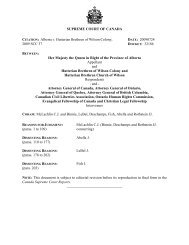- Page 1 and 2: BETWEENCOURT OF APPEAL FOR ONTARIOC
- Page 3 and 4: Page: 3ContentsBACKGROUND .........
- Page 5 and 6: Page: 5(3) Is the living on the ava
- Page 7 and 8: Page: 7principles of fundamental ju
- Page 9 and 10: Page: 9BACKGROUNDThe parties[10] Te
- Page 11 and 12: Page: 11212. (1) Every one who…(j
- Page 13 and 14: Page: 13makes it illegal for a pros
- Page 15 and 16: Page: 15cross-examination on some o
- Page 17 and 18: Page: 17the definition of “common
- Page 19 and 20: Page: 19In conclusion, these three
- Page 21 and 22: Page: 21[40] Turning to the ban on
- Page 23 and 24: Page: 23THE GOVERNMENTS’ APPEAL[4
- Page 25 and 26: Page: 25application judge and now p
- Page 27 and 28: Page: 27found that the liberty infr
- Page 29: Page: 29analyses that have applicat
- Page 34 and 35: Page: 34appropriate evidence and, w
- Page 36 and 37: Page: 36[82] Third, the application
- Page 38 and 39: Page: 38right to life, liberty and
- Page 40 and 41: Page: 40respondents‟ s. 7 liberty
- Page 42 and 43: Page: 42the respondent‟s rights m
- Page 44 and 45: Page: 44known to others, or monitor
- Page 46 and 47: Page: 46(a)The causation argument[1
- Page 48 and 49: Page: 48the physical cause of a par
- Page 50 and 51: Page: 50worse. Any real increase in
- Page 52 and 53: Page: 52prohibition had the effect
- Page 54 and 55: Page: 54determination that it also
- Page 56 and 57: Page: 56a role in determining wheth
- Page 58 and 59: Page: 58by a specific event. This l
- Page 60 and 61: Page: 60working at a venue under th
- Page 62 and 63: Page: 62record and her explicit fin
- Page 64 and 65: Page: 64Issues 6, 7 and 8: Does the
- Page 66 and 67: Page: 66[150] The fluidity of these
- Page 68 and 69: Page: 68concluded, at para. 134, th
- Page 70 and 71: Page: 70turning more directly to th
- Page 72 and 73: Page: 72immoral, it is also a fact
- Page 74 and 75: Page: 74it targets many of the soci
- Page 76 and 77: Page: 76[178] None of the parties,
- Page 78 and 79: Page: 78problem of prostitution and
- Page 80 and 81:
Page: 80violate the principle again
- Page 82 and 83:
Page: 82[197] The application judge
- Page 84 and 85:
Page: 84protect the public and in t
- Page 86 and 87:
Page: 86[208] Before the applicatio
- Page 88 and 89:
Page: 88(6) Are the bawdy-house pro
- Page 90 and 91:
Page: 90intact other Criminal Code
- Page 92 and 93:
Page: 92(1) Legislative history and
- Page 94 and 95:
Page: 94[229] This question is comp
- Page 96 and 97:
Page: 96that she is in the business
- Page 98 and 99:
Page: 98(3) Is the living on the av
- Page 100 and 101:
Page: 100prostitute can evolve into
- Page 102 and 103:
Page: 102[250] As it stands, the bl
- Page 104 and 105:
Page: 104(6) Is the living on the a
- Page 106 and 107:
Page: 106[263] In Schachter, Lamer
- Page 108 and 109:
Page: 108[269] We are satisfied tha
- Page 110 and 111:
Page: 110direction “may”.But th
- Page 112 and 113:
Page: 112objective and over-emphasi
- Page 114 and 115:
Page: 114Public solicitation for th
- Page 116 and 117:
Page: 116predecessor provision in H
- Page 118 and 119:
Page: 118[291] We agree with the ap
- Page 120 and 121:
Page: 120[297] In our view, the app
- Page 122 and 123:
Page: 122attributable on the eviden
- Page 124 and 125:
Page: 124In this case, it is the un
- Page 126 and 127:
Page: 126suggests that actual face-
- Page 128 and 129:
Page: 128prostitution is much safer
- Page 130 and 131:
Page: 130of an impact on prostitute
- Page 132 and 133:
Page: 132The declaration of invalid
- Page 134 and 135:
Page: 134the legislative objective
- Page 136 and 137:
Page: 136findings, the relevant Cri
- Page 138 and 139:
Page: 138[347] Drug possession, dru
- Page 140 and 141:
Page: 140The 2006 Subcommittee Repo
- Page 142 and 143:
Page: 142grounds under s. 15 of the
- Page 144 and 145:
Page: 144[362] With respect, this c
- Page 146 and 147:
Page: 146[367] With the prohibition
- Page 148:
Page: 148devastating impact on the
















